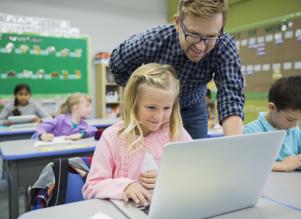1/16/2018
Social Emotional Learning is Here—Now What?
When the federal No Child Left Behind law was enacted in 2002, a new era of test-based accountability took root in the nation’s public schools. This meant high school students and students in grades 3 through 8 were tested annually in an effort to ensure they were "proficient" according to state education standards.
In the eyes of some, a key issue with this approach was that the required annual tests were largely limited to standardized assessments of students’ math and reading skills, with less frequent multiple-choice tests in science also administered. Many have argued that prioritizing results from annual standardized exams did not provide a comprehensive picture of how students were doing. Instead, researchers like Stanford professor Nel Noddings argued that schools need to educate children “holistically” by paying attention to their moral development or artistic tendencies—not just their ability to perform well on a math or reading test. Noddings even advocated for adding “happiness” to the list of things an education should help students achieve, partially by “making classrooms genuinely happy places.”
In late 2015, No Child Left Behind morphed into the Every Student Succeeds Act, providing a new take on federal education policy. This ushered in a push to revive social emotional learning, with a modern twist on how to adequately implement and assess the approach in a classroom setting. First, a quick definition: Social emotional learning is centered on the teaching of so-called “soft skills,” such as collaboration, cooperation, and awareness of one’s feelings. This is not a new concept in education—historians can trace it back to ancient Greek scholars such as Plato, who advocated for a well-rounded curriculum—but in the post-No Child Left Behind era, it is gaining greater prominence.
One reason soft skills are receiving more attention is that focusing on them can yield impressive results. In 2015, a National Public Radio segment zeroed in on what those results look like, and reported that kids who get early training in “self control and social skills” were better able to avoid “harder problems”—such as incarceration—later in life. This conclusion was based on a 1990s study by Duke University that tracked a group of children considered at risk for future “aggressive behavioral problems” who received coaching for both academic and non-academic skills. In a later review, the Duke researchers found that teaching kids to work in a group or think about “long-term consequences” had the most impact—even greater than the academic instruction—in terms of keeping the students on track to succeed in high school and beyond.
But if social emotional learning is mostly about “soft skills,” how can it be adequately implemented and assessed? Researchers at data analytics company Panorama Education advised schools to start by identifying the aspects of social emotional learning that they are most interested in evaluating. Do they want to start with an overall diagnostic tool to find out where students and staff are with their social emotional skills? Conversely, is the school ready to dig in and learn more about whether a particular lesson has been effective?
Once the purpose of the assessment is made clear, Panorama Education’s Liz Breese recommended sharing any social emotional learning data with all stakeholders in the community. That way, she wrote in a recent blog post, “everyone can identify opportunities for students to grow and for school culture to improve.” Researchers from the online site Edutopia also support the idea that fostering healthy social emotional learning at school can be beneficial to everyone, provided all participants—especially teachers—understand and support the implementation of new programming.
Ultimately, thoroughness, thoughtfulness, and long-term planning and engagement are needed to bring about successful social emotional learning, according to Vanessa Vega, a former senior researcher at Edutopia. For example, Vega found that district employees in Anchorage, Alaska, “developed an extensive library of learning materials for staff and students” that connected to new social emotional learning standards. This trove of supporting materials gave everyone a “greater stake in the success of the program” and, perhaps, led to happier and more successful students in the classroom.



